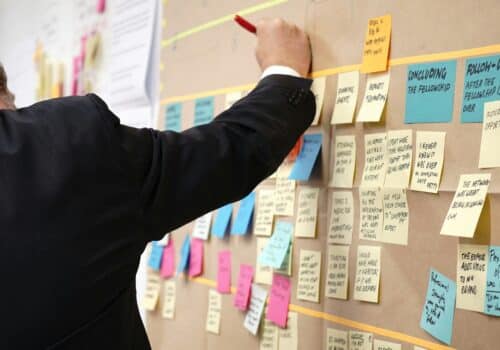October Connections video: The final stage of business transformation
In last month’s video, we discussed the third part of the business transformation journey: evaluation.
This month I’m talking about implementation, the fourth and final component of the Syte Business Transformation Framework.
When we talk about implementing an ERP solution, ultimately our goal is to ensure that your organization has the right solution to fuel long-term transformation and strategic growth.
Sometimes we find after we go through the steps of measuring, assessing, and evaluating that implementing new ERP software is the right way to go. Other times, we find it’s better to adapt a current ERP solution, expand current functionality, or optimize other technology solutions that are already in action.
An effective business transformation will integrate the people, processes, and other technology in your organization — and the right ERP solution serves as the foundation for this. It’s critical to get this right.
Watch the video here to learn more about how we implement the best solution for long-term strategic growth and transformation.
Video Transcription
Erin Koss, CEO at Syte Consulting Group with you today. Over the last three Connection videos, we’ve been talking about Syte’s Framework for Business transformation, and so today, much like last month, I’m going to add a little visual to the conversation to make it a little more fun and wanted to just revisit where we’ve been before today. Let’s talk about implement. You’ll recall the four steps in transformational change include measure, assess, evaluate, and implement.
I want to go back and revisit the first three so that we can get grounded in where it is and where we trying to go. I’ll make a point of sharing these slides with you in the Connection video today. The first step in business transformation is measure when our family-owned companies come to us and say that they are ready for an ERP solution. They say they are eady for business transformation, ready for big changes, and the kinds of changes that will get them where they are trying to go for the long term.
We all agree that ERP is foundational. You will likely need that to get you where you’re trying to go. But let’s take a look at whether you’re ready or not for making those big transformational changes. And so measure is all about that evaluation process.
When we get to assess, it’s a little bit of a deeper dive. We start talking about whether the organization has the capabilities and capacity within their people and their timelines and their busy work schedules to get them where they’re trying to go. Do they have the skills, capacity and availability? It also has a look at whether or not the business processes are well understood across the organization. In order to be aware of where it is that they really want to go.
What really matters right in terms of the business process, and what we find is when you ask different people, the answer differs. The idea here is to get an assessment across the board of where you’re at, where you’re trying to go and to get a common understanding of what matters most. Last month, we talked about evaluate and this idea that evaluations are tricky to do without an agnostic partner by your side, because the reality of it is these aren’t kinds of projects that most companies are doing very often. The risks, the time, the cost and, the wear-and-tear render people can be very, very high.
Essentially, the evaluate phase is trying to pick an ERP solution that is really meant to serve your functional, technical and vendor requirements and also is poised to get you where you’re trying to go for the long-term. So it’s not something you want to put in place or make a selection for the next couple of years.
You really want to think longer term. These are big investments that take some time and today, we want to focus on implement and and what that means.
When we talk about implementing an ERP solution that’s intended to fuel transformation in an organization for the long term, we’re talking ultimately about the foundation in place for what we call a new implementation. This thing here in the middle, but it can also include maybe you don’t need a new ERP solution. What you need to do is upgrade a really great solution that you already have. You need to expand the functionality.
Maybe that you’re using today or potentially just optimize the different pieces that you already have in place. Again, it can vary with whatever it is you might already have and where it is you’re trying to go. But implement is really making sure the right solution is being delivered to your organization again, to fuel that transformation and that long-term strategic growth plan. As we look at Syte’s framework for business transformation, you hear us talk a lot about ERP and the reason we do that is it’s foundational.
It’s not the whole story. But it is foundational, which means it’s got to be in place before all the other people process and technology alignment is really going to be able to get you where you’re trying to go strategically.
And so we talk about measure. We talk about a step. We talk about evaluate and implement, and you may be ready to jump in at any one of these places, depending on where you’re already gone. We’re here to meet you, where you’re at and try and get you where you’re trying to go.
Give us a call. We’d love to chat with you about how we can serve you best. Have a great day!
ERP Readiness Self-Assessment
Is your organization ready for a new or upgraded ERP solution? Find out with this complimentary self-assessment.
Doing Business Better
You strive for excellence, believe in your people, and want to do things right the first time. And you know that you need help to get to the heart of your business challenges and make the best choices for the future of your privately held manufacturing and distribution company. That’s where we come in.
We help you focus and find exactly the right path to accelerated growth and sustainable success — from your people to your processes to your ERP software.



